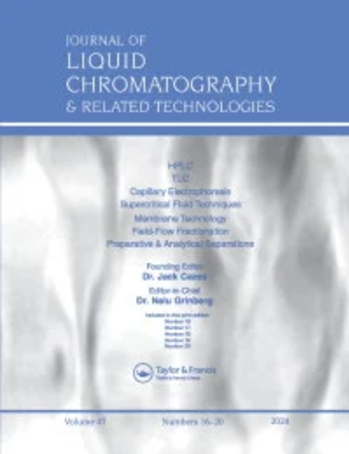Speciation and determination of inorganic antimony in tea infusion by using solid-phase extraction-based liquid chromatography-inductively coupled plasma-mass spectrometry
IF 1.2
4区 化学
Q4 BIOCHEMICAL RESEARCH METHODS
Journal of Liquid Chromatography & Related Technologies
Pub Date : 2023-07-03
DOI:10.1080/10826076.2023.2238824
引用次数: 0
Abstract
Abstract In this work, we developed a method to separate and detect inorganic antimony (iSb) in tea infusions based on liquid chromatography-inductively coupled plasma-mass spectrometry (LC-ICP-MS). Considering that iSb was present in tea infusions in trace amounts, a commercial solid-phase extraction (SPE) column was employed to enrich iSb(III) and iSb(V). In this study, we found that iSb exists in tea infusions in a bound state with an unknown substance rather than in a free state. Therefore, the enrichment step was combined with oxidation and reduction processes. Because of the enrichment process and the high sensitivity of LC-ICP-MS, the LODs of iSb(III) and iSb(V) were both as low as 0.03 μg L−1. The RSDs (n = 6) of iSb(III) and iSb(V) were all below 8.1%, and the recoveries (n = 6) were 92–96% and 90–94%, respectively. Then, a total of six tea infusion samples were inspected. The data revealed that the total Sb in the tea infusions ranged from 0.22 to 0.97 μg L−1, and we found that 50–83% of the total Sb in the tea infusion was iSb. This method is worth promoting since it has satisfying methodological performance. Graphical abstract固相萃取-液相色谱-电感耦合等离子体质谱法测定茶叶中无机锑的形态
摘要在本工作中,我们开发了一种基于液相色谱-电感耦合等离子体质谱法(LC-ICP-MS)分离和检测茶叶中无机锑(iSb)的方法。考虑到iSb以微量存在于茶叶冲泡中,采用商业固相萃取(SPE)柱富集iSb(III)和iSb(V)。在这项研究中,我们发现iSb在泡茶中以与未知物质结合的状态存在,而不是以游离状态存在。因此,富集步骤与氧化和还原过程相结合。由于富集过程和LC-ICP-MS的高灵敏度,iSb(III)和iSb(V)的检出限均低至0.03 μg L−1。RSD(n = 6) iSb(III)和iSb(V)的回收率均低于8.1% = 6) 分别为92–96%和90–94%。然后,总共检查了六个茶叶浸泡样品。数据显示,泡茶中的总锑含量在0.22-0.97之间 μg L−1,我们发现茶浸液中总Sb的50–83%是iSb。这种方法值得推广,因为它具有令人满意的方法性能。图形摘要
本文章由计算机程序翻译,如有差异,请以英文原文为准。
求助全文
约1分钟内获得全文
求助全文
来源期刊
CiteScore
2.80
自引率
0.00%
发文量
29
审稿时长
4.9 months
期刊介绍:
The Journal of Liquid Chromatography & Related Technologies is an internationally acclaimed forum for fast publication of critical, peer reviewed manuscripts dealing with analytical, preparative and process scale liquid chromatography and all of its related technologies, including TLC, capillary electrophoresis, capillary electrochromatography, supercritical fluid chromatography and extraction, field-flow technologies, affinity, and much more. New separation methodologies are added when they are developed. Papers dealing with research and development results, as well as critical reviews of important technologies, are published in the Journal.

 求助内容:
求助内容: 应助结果提醒方式:
应助结果提醒方式:


